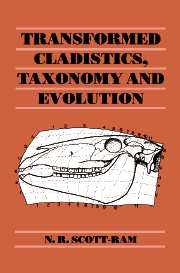Book contents
- Frontmatter
- Contents
- Preface
- Introduction
- PART I ISSUES PERTAINING TO THE PHILOSOPHY OF SCIENCE
- PART II THE STATUS OF THEORETICAL CLASSIFICATIONS
- PART III THE STATUS OF DESCRIPTIVE CLASSIFICATIONS
- 4 Phenetics and the descriptive attitude
- 5 Transformed cladistics and the methodological turn
- 6 Transformed cladistics and evolution
- Notes
- Bibliography
- Author index
- Subject index
4 - Phenetics and the descriptive attitude
Published online by Cambridge University Press: 21 October 2009
- Frontmatter
- Contents
- Preface
- Introduction
- PART I ISSUES PERTAINING TO THE PHILOSOPHY OF SCIENCE
- PART II THE STATUS OF THEORETICAL CLASSIFICATIONS
- PART III THE STATUS OF DESCRIPTIVE CLASSIFICATIONS
- 4 Phenetics and the descriptive attitude
- 5 Transformed cladistics and the methodological turn
- 6 Transformed cladistics and evolution
- Notes
- Bibliography
- Author index
- Subject index
Summary
Introduction
The origins of phenetics can be traced back to two separate sources – firstly the definitive papers of Gilmour, and secondly the availability of computers in the 1950s and the subsequent development of phenetic clustering methods for classification. It has been suggested that the French botanist, Michel Adanson (1827–1906), was the founding father of phenetics, but this is misleading since Adanson did not use the numerical approach in the actual delimiting of genera and families. The numerical methods developed by pheneticists had the virtue of being able to handle quantities of data whose structure could not be grasped by simple inspection, and they aimed to eradicate all the more intuitive methods implicit within evolutionary systematics. With the advent of explicit numerical techniques for inferring phylogenics in the late 1960s, phenetics was no longer synonymous with numerical taxonomy. The latter came to have two areas of investigation: numerical phenetics and numerical evolutionary (cladistic) methods. In this section we will be dealing only with numerical phenetics, the grouping by numerical methods, of taxonomic units into taxa on the basis of their character states. I will not discuss the numerical methods involved in any great detail since our concern is with the steps involved in classifying, and the underlying assumptions, rather than with a strict exposition of numerical methods. Such expositions can be found in Jardine & Sibson's Mathematical Taxonomy and Dunn & Everitt's An Introduction to Mathematical Taxonomy.
- Type
- Chapter
- Information
- Transformed Cladistics, Taxonomy and Evolution , pp. 105 - 132Publisher: Cambridge University PressPrint publication year: 1990



